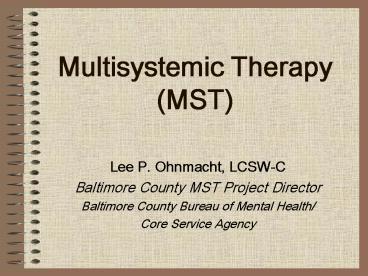Multisystemic Therapy MST - PowerPoint PPT Presentation
1 / 12
Title:
Multisystemic Therapy MST
Description:
NIDA, Center for Substance Treatment (CSAT) & Center for Substance Abuse Prevention (CSAP) ... with negative peers, alcohol and drug use, out-of-home placement, ... – PowerPoint PPT presentation
Number of Views:584
Avg rating:3.0/5.0
Title: Multisystemic Therapy MST
1
Multisystemic Therapy (MST)
- Lee P. Ohnmacht, LCSW-C
- Baltimore County MST Project Director
- Baltimore County Bureau of Mental Health/
- Core Service Agency
2
What is MST?
- Community-based, family-driven treatment for
antisocial/delinquent behavior - Focus is on empowering caregivers to solve
current and future problems - MST client is the entire ecology of the youth -
family, peers, school, neighborhood - Highly structured supervision and quality
assurance processes are employed
3
Who is eligible? (Baltimore County eligibility
criteria)
- Youth must meet ALL the following
- Youth under formal DJS supervision (COMPACT
eligible) - (However,at one time, youth with history of at
least one arrest or an established pattern of
delinquency were eligible) - Live with his/her family or a long-term foster
family - Live in Baltimore County
- Ages 11-17
- IQ above 70
4
Who is not eligible?
- Youth who have ANY of the following are NOT
eligible - Diagnosis of autism or PDD
- In need of immediate hospitalization
- Referred because of a sexual offense without
other delinquent behaviors
5
MST Assumptions Beliefs
- Childrens behavior is strongly influenced by
their families, friends and communities (and vice
versa) - Families are key to success
- Families can live successfully without formal,
mandated services - Change can occur quickly
- Professional treatment providers should be
accountable for achieving outcomes - Science/research can provide guidance
6
Ecological Model
Community/Culture
Neighborhood
School
Peers
Family
Child
7
How is MST Implemented?
- Single therapist working intensively with 4 to 6
families at a time - 4-6 months is the typical treatment time.
- Work is done in the community home, school
neighborhood, etc. - MST staff deliver all treatment.
- MST staff take a lead role in clinical decision
making for each case.
8
Evidence-Based Practice
- U.S. Surgeon General Report on Mental Health and
Report on Youth Violence - U.S. Department of Justice-OJJDP
- NIDA, Center for Substance Treatment (CSAT)
Center for Substance Abuse Prevention (CSAP) - National Association of State Mental Health
Program Directors (NASMHPD) - Washington State Institute of Public Policy
- Blueprints for Violence Prevention
9
MST Outcomes
- Research documents a reduction in the following
- Recidivism, association with negative peers,
alcohol and drug use, out-of-home placement, and
violent crime. - Research documents an improvement in the
following - Family and peer relations, caregiver discipline
practice, youth school and vocational performance.
10
Outcomes FY 2003- FY 2007 Baltimore County MST
- MST resulted in fewer re-arrests (N191)
- 34 of youth were re-arrested 2.7 years
following MST treatment. - Source Schaeffer, Cindy M. (2007) Outcomes for
Baltimore County Youth Strategies Program
Evaluation - Percent of youth living at home 81
- Percent of youth in school/working 76
- Percent of youth with no new arrests 77
- Source MST Institute Program Implementation Data
Report 1/2002-10/2007
11
Outcomes FY 04 FY 05Baltimore County MST
- Number of youth treated 77
- Number of youth who completed MST 51
- Percent of completers placed out-of-the home 29
or 71 not placed - Source Review of DJS archival records for youth
who received MST
12
Resources
- MST Services
- www.mstservices.com
- Blueprints for Violence Prevention
- www.colorado.edu/cspv/blueprints/index.html
- SAMHSA Model Programs
- http//modelprograms.samhsa.gov
- Social Programs that Work
- http//www.evidencebasedprograms.org/































